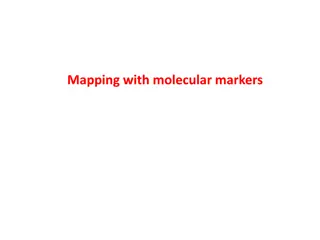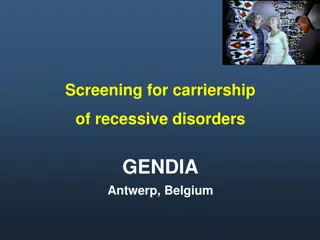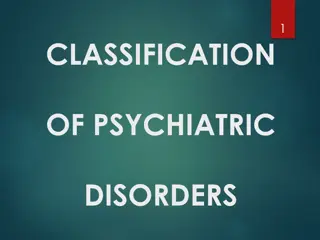Overview of Genetic and Congenital Disorders and Their Causes
Explore the terminology, causes, characteristics, and results of genetic and congenital disorders, as well as the disorders of single-gene inheritance. Learn about autosomal dominant disorders like Marfan Syndrome and Neurofibromatosis. Discover how single-gene disorders are inherited and their impact on protein production and enzyme function.
Download Presentation

Please find below an Image/Link to download the presentation.
The content on the website is provided AS IS for your information and personal use only. It may not be sold, licensed, or shared on other websites without obtaining consent from the author. Download presentation by click this link. If you encounter any issues during the download, it is possible that the publisher has removed the file from their server.
E N D
Presentation Transcript
GENETIC AND CONGENITAL DISORDERS
TERMINOLOGY OF GENETIC AND CONGENITAL DISORDERS Congenital Allele Gene locus Gene mutation Genotype Phenotype Homozygous Heterozygous Polymorphism Gene penetrance Gene expression
CAUSES OF BIRTH DEFECTS Genetic Factors Single-gene, multifactorial inheritance or chromosomal aberrations Environmental Factors (Fetal Development) Maternal disease, infections, or drugs taken during pregnancy Intrauterine Factors (Rare) Fetal crowding, positioning, or entanglement of fetal parts with the amnion
CHARACTERISTICS OF SINGLE-GENE DISORDERS Caused by a single defective or mutant gene May be present on an autosome or the X chromosome May affect one member or both members of an autosomal gene pair Defects follow the mendelian patterns of inheritance Characterized by their patterns of transmission Obtained through a family genetic history
RESULT OF SINGLE-GENE DISORDERS Formation of an abnormal protein or decreased production of a gene product Defective or decreased amounts of an enzyme Defects in receptor proteins and their function Alterations in nonenzyme proteins Mutations resulting in unusual reactions to drugs
DISORDERS OF SINGLE-GENE INHERITANCE (MENDELIAN) Autosomal Dominant A single mutant allele from an affected parent is transmitted to an offspring regardless of sex Autosomal Recessive Manifested only when both members of the gene pair are affected (both parents unaffected, but carriers) X-linked Recessive Always associated with the X chromosome; the inheritance pattern is predominately recessive.
AUTOSOMAL DOMINANT DISORDERS Marfan Syndrome A connective tissue disorder manifested by changes in the skeleton, eyes, and cardiovascular system Neurofibromatosis (NF) A condition involving neurogenic tumors that arise from Schwann cells and other elements of the peripheral nervous system
AUTOSOMAL RECESSIVE DISORDERS Phenylketonuria (PKU) A rare metabolic disorder caused by a deficiency of the liver enzyme phenylalanine hydroxylase Tay-Sachs Disease A variant of a class of lysosomal storage diseases, known as gangliosidoses Gangliosides in the membranes of nervous tissue are deposited in neurons of the central nervous system and retina because of a failure of lysosomal degradation
X-LINKED DISORDER Fragile X syndrome Associated with a fragile site on the X chromosome where the chromatin fails to condense during mitosis Affects more males than females Approximately 1 in 1000 male infants Second most common cause of mental retardation after Down syndrome
CHARACTERISTICS OF MULTIFACTORIAL INHERITANCE DISORDERS Caused by multiple genes and environmental factors. The exact number of genes is not known. Traits do not follow a clear-cut pattern of inheritance. Disorders can be expressed during fetal life and be present at birth, or expressed later in life.
EXAMPLES OF MULTIFACTORIAL INHERITANCE DISORDERS Cleft lip or palate Clubfoot Congenital dislocation of the hip Congenital heart disease Pyloric stenosis Urinary tract malformation
RESULTS OF CHROMOSOMAL DISORDERS Reproductive wastage (early gestational abortions) Congenital malformations Mental retardation Linked to more than 60 identifiable syndromes present in birth
TYPES OF CHROMOSOMAL DISORDERS Alterations in chromosome duplication Alterations in chromosome number Trisomy 21 (Down syndrome) Monosomy X (Turner syndrome) Polosomy X (Klinefelter syndrome) Alterations in chromosome structure
MITOCHONDRIAL DNA DISORDERS Subject to mutations at a higher rate than nuclear DNA No repair mechanisms Disorders of mitochondrial genes interfere with production of cellular energy Lead to the production of energy reactive oxygen species, or disrupt the generation of signals that initiate apoptosis Commonly associated with neuromuscular disorders
DISORDERS CAUSED BY ENVIRONMENTAL INFLUENCES Teratogenic agents: produce abnormalities during embryonic or fetal development Most susceptible to these agents during organogenesis
TERATOGENIC AGENTS Radiation Chemicals and drugs Fetal alcohol syndrome Cocaine babies Folic acid deficiency Infectious agents
CRITERIA FOR DEFINING FETAL ALCOHOL SYNDROME Prenatal or postnatal growth retardation Weight or length below the 10th percentile Central nervous system involvement Neurologic abnormalities Developmental delays Behavioral dysfunction Intellectual impairment Skull and brain malformation
CRITERIA FOR DEFINING FETAL ALCOHOL SYNDROME (CONT.) A characteristic face Short palpebral fissures (eye openings) Thin upper lip Elongated, flattened midface, and philtrum
EFFECTS OF COCAINE USE DURING PREGNANCY Decrease in uteroplacental blood flow Maternal hypertension Stimulation of uterine contractions Fetal vasoconstriction
OTHER MEDICATIONS DURING PREGNANCY Possibilities of cytotoxic (cell-killing), antimetabolic, or growth-inhibiting activities Vitamin A derivatives Folic acid deficiency
INFECTIOUS AGENTS DURING PREGNANCY TORCH Varicella-zoster virus infection Listeriosis Leptospirosis Epstein-Barr virus infection Tuberculosis and syphilis Human immunodeficiency virus (HIV) Human parvovirus (B19) Toxoplasmosis Other Rubella Cytomegalovirus Herpes
COMPONENTS OF A GENETIC ASSESSMENT Assessment of genetic risk and prognosis Detailed family history Pregnancy history Detailed accounts of birth process Accounts of postnatal health and development Physical examination of the affected child and family Laboratory tests
PURPOSES OF A PRENATAL DIAGNOSIS Provide parents with information needed to make informed choice about having a child with abnormality Provide reassurance and reduce anxiety among high- risk groups Allow parents at risk to begin pregnancy with assurance that knowledge about the presence or absence of a disorder can be confirmed with testing
METHODS USED FOR FETAL DIAGNOSIS Maternal blood screening Ultrasonography Amniocentesis Chorionic villus sampling Percutaneous umbilical cord blood sampling Fetal biopsy Cytogenetic and biochemical analyses























